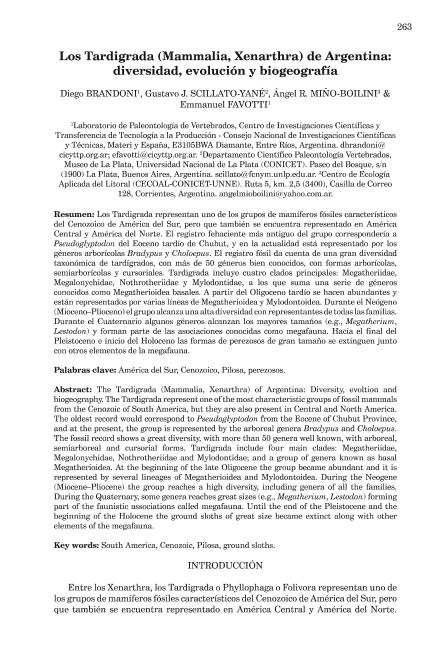Mostrar el registro sencillo del ítem
dc.contributor.author
Brandoni, Diego

dc.contributor.author
Scillato Yané, Gustavo J.
dc.contributor.author
Miño Boilini, Ángel Ramón

dc.contributor.author
Favotti, Sergio Emmanuel

dc.date.available
2023-01-05T12:21:52Z
dc.date.issued
2016-04
dc.identifier.citation
Brandoni, Diego; Scillato Yané, Gustavo J.; Miño Boilini, Ángel Ramón; Favotti, Sergio Emmanuel; Los Tardigrada (Mammalia, Xenarthra) de Argentina: Diversidad, evolución y biogeografía; Museo Argentino de Ciencias Naturales "Bernardino Rivadavia"; Contribuciones del MACN; 6; 4-2016; 263-274
dc.identifier.issn
1666-5503
dc.identifier.uri
http://hdl.handle.net/11336/183477
dc.description.abstract
Los Tardigrada representan uno de los grupos de mamíferos fósiles característicos del Cenozoico de América del Sur, pero que también se encuentra representado en América Central y América del Norte. El registro fehaciente más antiguo del grupo correspondería a Pseudoglyptodon del Eoceno tardío de Chubut, y en la actualidad está representado por los géneros arborícolas Bradypus y Choloepus. El registro fósil da cuenta de una gran diversidad taxonómica de tardígrados, con más de 50 géneros bien conocidos, con formas arborícolas, semiarborícolas y cursoriales. Tardigrada incluye cuatro clados principales: Megatheriidae, Megalonychidae, Nothrotheriidae y Mylodontidae, a los que suma una serie de géneros conocidos como Megatherioidea basales. A partir del Oligoceno tardío se hacen abundantes y están representados por varias líneas de Megatherioidea y Mylodontoidea. Durante el Neógeno (Mioceno–Plioceno) el grupo alcanza una alta diversidad con representantes de todas las familias. Durante el Cuaternario algunos géneros alcanzan los mayores tamaños (e.g., Megatherium, Lestodon) y forman parte de las asociaciones conocidas como megafauna. Hacia el final del Pleistoceno e inicio del Holoceno las formas de perezosos de gran tamaño se extinguen junto con otros elementos de la megafauna.
dc.description.abstract
The Tardigrada represent one of the most characteristic groups of fossil mammals from the Cenozoic of South America, but they are also present in Central and North America. The oldest record would correspond to Pseudoglyptodon from the Eocene of Chubut Province, and at the present, the group is represented by the arboreal genera Bradypus and Choloepus. The fossil record shows a great diversity, with more than 50 genera well known, with arboreal, semiarboreal and cursorial forms. Tardigrada include four main clades: Megatheriidae, Megalonychidae, Nothrotheriidae and Mylodontidae; and a group of genera known as basal Megatherioidea. At the beginning of the late Oligocene the group became abundant and it is represented by several lineages of Megatherioidea and Mylodontoidea. During the Neogene (Miocene–Pliocene) the group reaches a high diversity, including genera of all the families. During the Quaternary, some genera reaches great sizes (e.g., Megatherium, Lestodon) forming part of the faunistic associations called megafauna. Until the end of the Pleistocene and the beginning of the Holocene the ground sloths of great size became extinct along with other elements of the megafauna.
dc.format
application/pdf
dc.language.iso
spa
dc.publisher
Museo Argentino de Ciencias Naturales "Bernardino Rivadavia"
dc.rights
info:eu-repo/semantics/openAccess
dc.rights.uri
https://creativecommons.org/licenses/by-nc-sa/2.5/ar/
dc.subject
América del Sur
dc.subject
Pilosa
dc.subject
Cenozoico
dc.subject
Perezosos
dc.subject.classification
Oceanografía, Hidrología, Recursos Hídricos

dc.subject.classification
Ciencias de la Tierra y relacionadas con el Medio Ambiente

dc.subject.classification
CIENCIAS NATURALES Y EXACTAS

dc.title
Los Tardigrada (Mammalia, Xenarthra) de Argentina: Diversidad, evolución y biogeografía
dc.title
The Tardigrada (Mammalia, Xenarthra) of Argentina: Diversity, evoltion and biogeography
dc.type
info:eu-repo/semantics/article
dc.type
info:ar-repo/semantics/artículo
dc.type
info:eu-repo/semantics/publishedVersion
dc.date.updated
2017-10-04T14:50:52Z
dc.journal.number
6
dc.journal.pagination
263-274
dc.journal.pais
Argentina

dc.journal.ciudad
Ciudad Autónoma de Buenos Aires
dc.description.fil
Fil: Brandoni, Diego. Provincia de Entre Ríos. Centro de Investigaciones Científicas y Transferencia de Tecnología a la Producción. Universidad Autónoma de Entre Ríos. Centro de Investigaciones Científicas y Transferencia de Tecnología a la Producción. Consejo Nacional de Investigaciones Científicas y Técnicas. Centro Científico Tecnológico Conicet - Santa Fe. Centro de Investigaciones Científicas y Transferencia de Tecnología a la Producción; Argentina
dc.description.fil
Fil: Scillato Yané, Gustavo J.. Universidad Nacional de La Plata. Facultad de Ciencias Naturales y Museo. División Paleontología Vertebrados; Argentina
dc.description.fil
Fil: Miño Boilini, Ángel Ramón. Consejo Nacional de Investigaciones Científicas y Técnicas. Centro Científico Tecnológico Conicet - Nordeste. Centro de Ecología Aplicada del Litoral. Universidad Nacional del Nordeste. Centro de Ecología Aplicada del Litoral; Argentina
dc.description.fil
Fil: Favotti, Sergio Emmanuel. Provincia de Entre Ríos. Centro de Investigaciones Científicas y Transferencia de Tecnología a la Producción. Universidad Autónoma de Entre Ríos. Centro de Investigaciones Científicas y Transferencia de Tecnología a la Producción. Consejo Nacional de Investigaciones Científicas y Técnicas. Centro Científico Tecnológico Conicet - Santa Fe. Centro de Investigaciones Científicas y Transferencia de Tecnología a la Producción; Argentina
dc.journal.title
Contribuciones del MACN
dc.relation.alternativeid
info:eu-repo/semantics/altIdentifier/url/http://naturalis.fcnym.unlp.edu.ar/repositorio/_documentos/sipcyt/bfa005048.pdf
Archivos asociados
